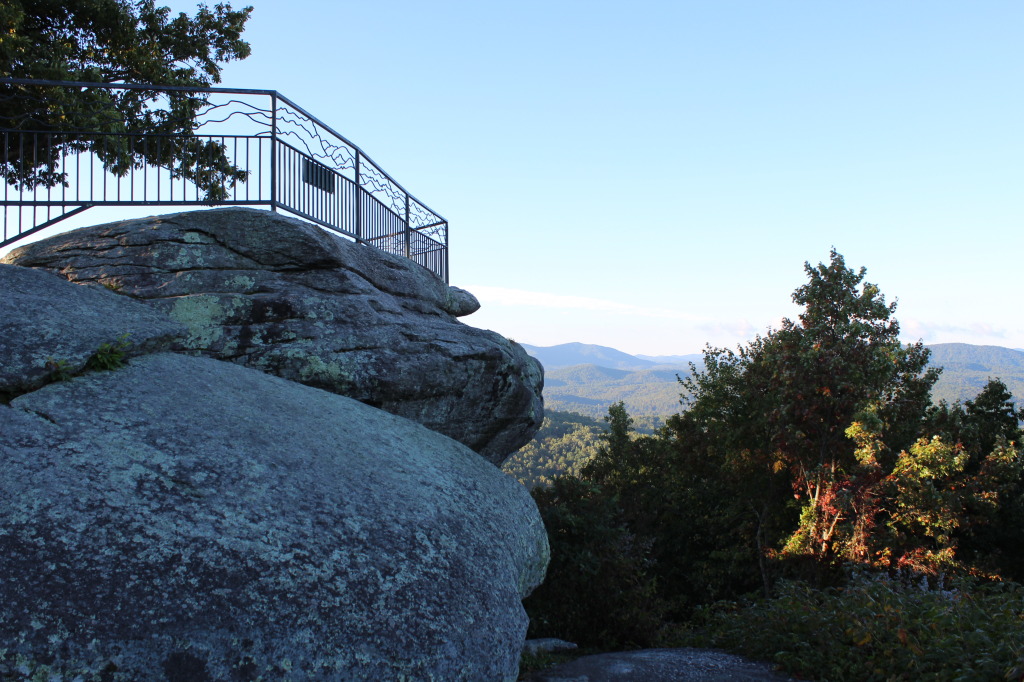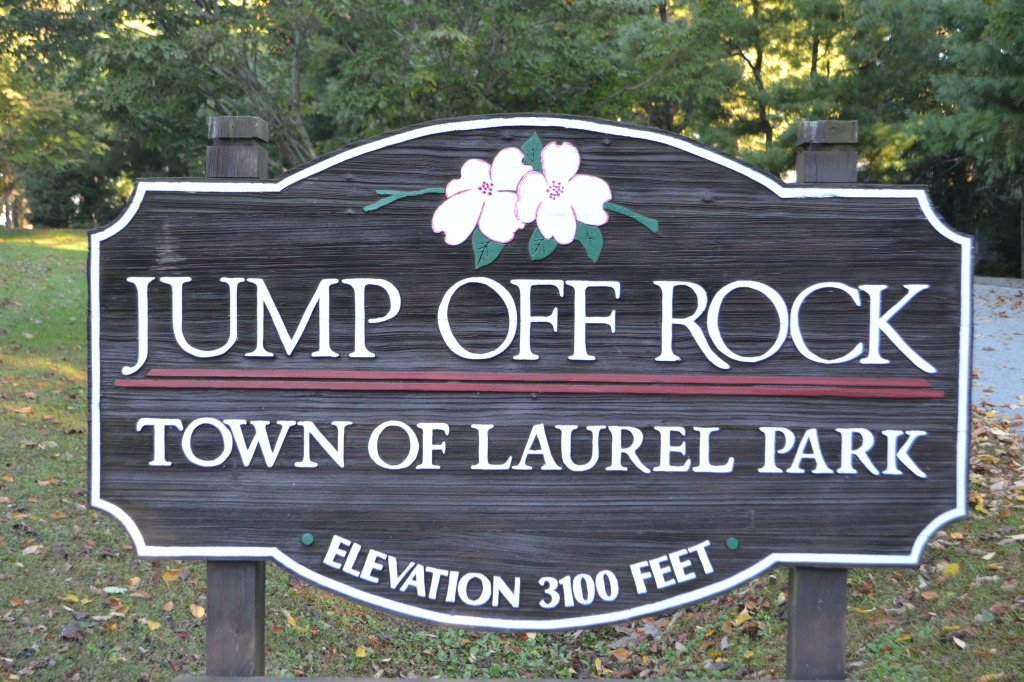Lindsey Deal emerged from a swung-open wooden door behind the cash register in the same way Deal Orchards appeared from the road. Driving along Highway 64, the storefront for the orchard looked like a white tin warehouse, named for, perhaps, the bargain-priced produce inside. In reality, it was for the man whose family had founded and run the business for generations, carried on still today. The cashier, busy ringing up boxes of apples, apple butter, apple cider, and old-fashioned candies, called Lindsey on her flip phone to answer a few questions on the business; and there he came, extending a long tree-branch arm beckoning into his office.
Lindsey Deal is a human torch of North Carolina apple country. A tall man with grey hair and beard, Lindsey wore black baseball cap and khaki button down, both branded by the “Enjoy North Carolina Apples” insignia, the “O” of “Enjoy” a bright red fruit. His accent was certainly Southern, a characteristic of his Taylorsville community though occasionally too thick for Northern ears. He was curi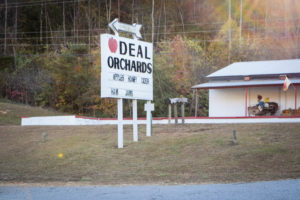 ous about how Northern eyes saw his little piece of North Carolina, prioritizing a good impression of a place he clearly took pride in. In fact, Taylorsville had been, he said, the capital of the American apple industry for decades, which his great-grandfather had a hand in.
ous about how Northern eyes saw his little piece of North Carolina, prioritizing a good impression of a place he clearly took pride in. In fact, Taylorsville had been, he said, the capital of the American apple industry for decades, which his great-grandfather had a hand in.
Ready and eager to embark on a thorough history of NC apple country, Lindsey relaxed into his leather desk chair, hands laced together across his belly. His personality was strewn across the wood-paneled walls of his office. From the NRA sign on the back of his office door, to the two elk heads mounted on the wall, to the mosaic of family photos–his children, grandchildren, and ancestors who he introduces–a presumably conservative, Southern persona emerges. Yet throughout his explanations of the culture of his region, his face lit up with enthusiasm. According to Lindsey, this county used to be the moonshine capital of the country, connecting to the popularity of NASCAR in the community. He claims that NASCAR stems from moonshiners “pumping” up their cars to escape the law during Prohibition. Through his stories, Lindsey’s character slowly evolved into a richly diverse man both of traditionalism and understanding.
While the Deals originate from Kentucky, the Deal family has been harvesting apples in the county surrounding Taylorsville for well over 100 years. As Lindsey regaled the history of Deal Orchard, he rose from his chair to point to the largest frame on the wall. Inside is a black-and-white photograph capturing three rows of men, most of whom were dressed in their Sunday best–as Lindsey points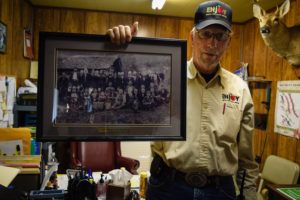 out, some of whom wore farmer’s overalls, and two of whom sported bushy white beards. The entire scene, set outside on an agricultural property, looked like it could have been torn from a Civil War history book. One of the two white-bearded men, however, was Lindsey’s great-grandfather–the original Deal’s Apples. The photo is of the first North Carolina Apple Growers’ Association, a group established to align NC apple farmers to compete and cooperate with larger wholesale produce markets. While Lindsey’s great-grandfather chose to partake in this industry, his brother (Lindsey’s great-uncle) chose to start a hardware store. Many will recognize it today as Lowe’s Home Improvement. Now onto the sixth-generation of apple Deal’s, Lindsey’s daughter left her job working numbers at Lowe’s to help run Deal’s Orchard with Lindsey’s other son.
out, some of whom wore farmer’s overalls, and two of whom sported bushy white beards. The entire scene, set outside on an agricultural property, looked like it could have been torn from a Civil War history book. One of the two white-bearded men, however, was Lindsey’s great-grandfather–the original Deal’s Apples. The photo is of the first North Carolina Apple Growers’ Association, a group established to align NC apple farmers to compete and cooperate with larger wholesale produce markets. While Lindsey’s great-grandfather chose to partake in this industry, his brother (Lindsey’s great-uncle) chose to start a hardware store. Many will recognize it today as Lowe’s Home Improvement. Now onto the sixth-generation of apple Deal’s, Lindsey’s daughter left her job working numbers at Lowe’s to help run Deal’s Orchard with Lindsey’s other son.
At Deal Orchard’s Lindsey sells about 80,000 bushels of apples per year. The very units used for apple sales has evolved over the years, he says, in correspondence to changing gender norms. According to Lindsey, the apple industry began selling half bushels because a bushel box was too heavy for women–who did all the shopping–to carry. When women went back to work, however, they stopped buying apples in such large increments altogether. Lindsey said that women will full-time jobs were more likely to buy groceries for the night or a week, too busy to make pies or other more elaborate dinner measures apple-related extras in addition to employment. From this, the industry developed the “peck,” an even smaller increment of apples. While describing how feminism altered the apple industry, Lindsey remained a neutral tone, not condescending to a movement that altered his family’s practices. Rather, he was empathetic overall, if not overtly supportive–employing a level of respect that created interest amongst his NRA poster and elk heads.
As a well-established apple man, many beginning farmers come to Lindsey to ask advice to begin an orchard of their own. Lindsey laughs to himself when this happens, knowing how they underestimate the “hard parts” of farming. To establish an orchard, one must purchase land, equipment costing upwards of $6,000, and seeds to plant the trees. From there, farmers have to wait at least six years for the trees to grow for any return on their investment. He tries to pass on some wisdom, of course. For example, Lindsey has his orchards scattered across Taylorsville rather than in one area, so if there is a storm, not every orchard is impacted. One hailstorm can knock out a farm for 18 months, Lindsey said; when there’s bad weather, most people don’t even think about how this affects the farmers.
To continue constructing a behind-the-scenes look at the farming process-and to build the empathy of the farmer’s life–Lindsey provided a tour through his refrigeration units and warehouse. The massive refrigerator, full of innumerable wooden crates, smells crisp and sweet like ice-cold cider. There is actually cider in the fridge, which is outsourced for production due to strict health standards but made from Deal apples. Lindsey said, while he would like to, it is impossible to grow organic fruit in the East. There’s too much rain, which promotes fungus and rot without chemicals. Deal Orchards are, however, GAP (Good Agriculture Practices) certified.
He proceeded to walk through the entire apple-sorting process, from the conveyer belts, to turning on the washing mechanisms, to showing how each moving process worked–how apples were sorted by hand and through machine into high and low quality piles. He pointed to a 30-foot stack of boxes, with High Quality and Low Quality written in different colors. Years back, Lindsey’s customers would switch apples from high and low quality boxes in attempt to pay the lower price, so Lindsey color-coded the boxes so he wouldn’t be swindled.
Finally he approached a box of small red-green apples, the size of which make them most appealing 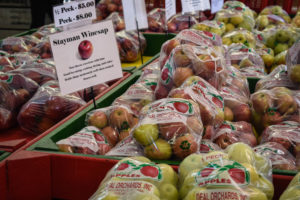 to deer hunters. These were Bushy Mountain Limbertwigs– native to the region and the very apple that his great-grandfather grew to found Deal Orchards. He picked up one apple and offered a bite to anyone with “good teeth.” The consistency was firm, difficult to chew, but flavorfully balanced between tart and sweet. He took another apple and placed it on the ground, proceeding to step and place his entire weight on it. Then he picked up the apple again to reveal that there were no dents or bruises.
to deer hunters. These were Bushy Mountain Limbertwigs– native to the region and the very apple that his great-grandfather grew to found Deal Orchards. He picked up one apple and offered a bite to anyone with “good teeth.” The consistency was firm, difficult to chew, but flavorfully balanced between tart and sweet. He took another apple and placed it on the ground, proceeding to step and place his entire weight on it. Then he picked up the apple again to reveal that there were no dents or bruises.
The day with Lindsey concluded with one last question: What was his favorite apple? He answered that if he was ever out in the orchard–after all the customers had come and gotten their pick–and he saw one last Golden Delicious, he would climb to the top of a tree to get it.
From there he returned inside to his office, encouraging a car ride through the orchards, just off to the west. Lindsey Deal tucked himself away as quickly as he had shown himself; he was a representation of the apple country in the nicest way: a man of history, tradition entwined with progression, and a Southern hospitality that opened and welcomed an eye into Taylorsville, North Carolina.

 native to the usual bar we had become accustomed to college towns. The bar describes themselves as “
native to the usual bar we had become accustomed to college towns. The bar describes themselves as “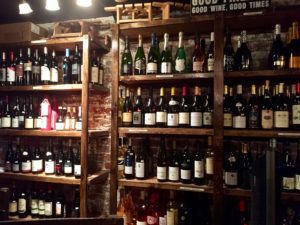 ndmade in the early morning and served up until dinner time. The produce and cheeses are outsourced as locally as possible, giving business to the booming farms of local Hendersonville.
ndmade in the early morning and served up until dinner time. The produce and cheeses are outsourced as locally as possible, giving business to the booming farms of local Hendersonville. 


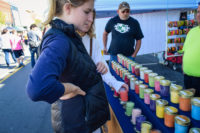

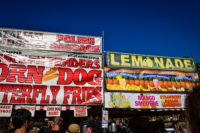
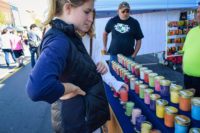
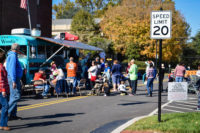
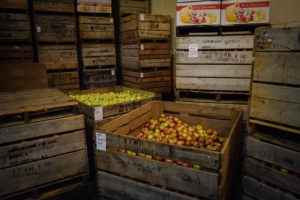 neral direction, and we were met face-to-face with Lindsay Deal: the man behind every aspect of the growing, harvesting and marketing for one of the largest, and oldest, apple orchards in North Carolina. His face was colored initially skeptical, noticeably sizing us up as outsiders. Upon a brief explanation, however, he was more than compliant to talk about North Carolina culture across the Foothills. He opened that same wooden door he had come through just a few minutes age before, and invited us into his office.
neral direction, and we were met face-to-face with Lindsay Deal: the man behind every aspect of the growing, harvesting and marketing for one of the largest, and oldest, apple orchards in North Carolina. His face was colored initially skeptical, noticeably sizing us up as outsiders. Upon a brief explanation, however, he was more than compliant to talk about North Carolina culture across the Foothills. He opened that same wooden door he had come through just a few minutes age before, and invited us into his office.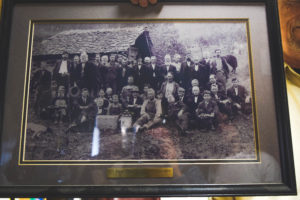 single seller who would then sell their apples to the major grocery chains.
single seller who would then sell their apples to the major grocery chains.  ’s competition has tapered out over the years, leaving just three or four primary orchards to spearhead the Foothill markets. Lindsay and his team have their process down to an absolute science and are Good Agriculture Practices-Certified. If you find yourself traveling through Alexander County, be sure to stop by the Deal Apple House and get a taste of what this family’s combination of passion and expertise has produced.
’s competition has tapered out over the years, leaving just three or four primary orchards to spearhead the Foothill markets. Lindsay and his team have their process down to an absolute science and are Good Agriculture Practices-Certified. If you find yourself traveling through Alexander County, be sure to stop by the Deal Apple House and get a taste of what this family’s combination of passion and expertise has produced. s of apples, each labeled in the same cursive handwriting. Above them lies an entire wall of cowboy hats in every color you imaginable. To the left appears about every type of butter and jam known to man, each in the same gold-lidded mason jar. The place gave me that same feeling I get in my grandmother’s attic, cluttered yet somehow everything seems to hold some sort of memory or value.
s of apples, each labeled in the same cursive handwriting. Above them lies an entire wall of cowboy hats in every color you imaginable. To the left appears about every type of butter and jam known to man, each in the same gold-lidded mason jar. The place gave me that same feeling I get in my grandmother’s attic, cluttered yet somehow everything seems to hold some sort of memory or value. 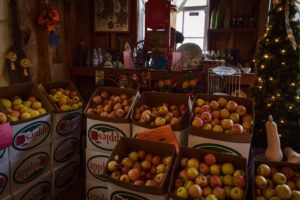 Chicago local.
Chicago local. 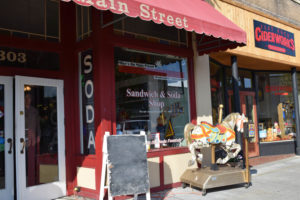 h register. A young waiter dressed in a light blue bow tie and old-fashioned paper hat hurries past, his arms precariously balanced with food. He smiled and sent off a, “Sit where you like,” in passing.
h register. A young waiter dressed in a light blue bow tie and old-fashioned paper hat hurries past, his arms precariously balanced with food. He smiled and sent off a, “Sit where you like,” in passing. 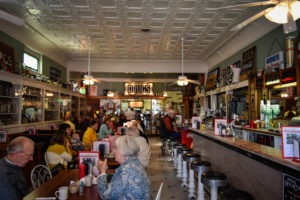 owns and put in orders for some piping hot coffee.
owns and put in orders for some piping hot coffee.  fter a short wait, while no room for disappointment. The general concept of Mike’s breakfast bowls begins with your choice of a hash brown or grits base. Next comes two eggs prepared to your liking, fried comes highly recommended, and then finally a last layer of whatever toppings come with the bowl of your choosing. The Denver bowl is garnished with ham, tomatoes, green pepper, onions and a whole lot of cheddar cheese. The flavors of the dish are perfectly proportioned, neither too overpowering or understated, achieving a perfect point of content fullness–that is, pre-pancakes, browned to perfection and fluffy like you can only find at a diner. A return visit to Hendersonville Mike’s pancakes will definitely be at the top of Hendersonville’s to-eat list.
fter a short wait, while no room for disappointment. The general concept of Mike’s breakfast bowls begins with your choice of a hash brown or grits base. Next comes two eggs prepared to your liking, fried comes highly recommended, and then finally a last layer of whatever toppings come with the bowl of your choosing. The Denver bowl is garnished with ham, tomatoes, green pepper, onions and a whole lot of cheddar cheese. The flavors of the dish are perfectly proportioned, neither too overpowering or understated, achieving a perfect point of content fullness–that is, pre-pancakes, browned to perfection and fluffy like you can only find at a diner. A return visit to Hendersonville Mike’s pancakes will definitely be at the top of Hendersonville’s to-eat list.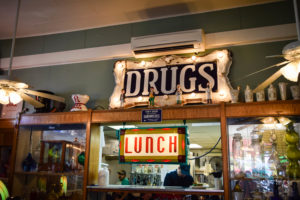

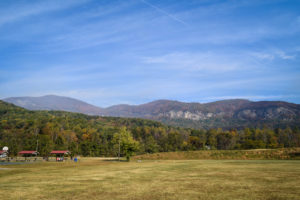 across abandoned-looking towns, and several fruit stands, you will see the scen e emerge from around the bend: the infamous Lake Lure, zig-zagging around rugged mountain ranges.
across abandoned-looking towns, and several fruit stands, you will see the scen e emerge from around the bend: the infamous Lake Lure, zig-zagging around rugged mountain ranges.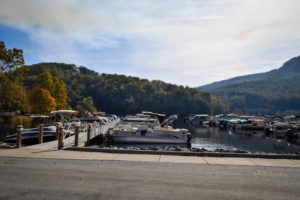 Lake Lure’s public garden, passing couples holding hands and babies in strollers–caught in the aura of simple contentedness. An aerial view of the lake exposes a quiet gazebo in the distance that looks out to one of the most beautiful views along Highway 64. The contrast between the mountains and lake may remind you of the changing North Carolina landscape along Highway 64, shifting between the coastal plains, foothills, and mountains.
Lake Lure’s public garden, passing couples holding hands and babies in strollers–caught in the aura of simple contentedness. An aerial view of the lake exposes a quiet gazebo in the distance that looks out to one of the most beautiful views along Highway 64. The contrast between the mountains and lake may remind you of the changing North Carolina landscape along Highway 64, shifting between the coastal plains, foothills, and mountains. 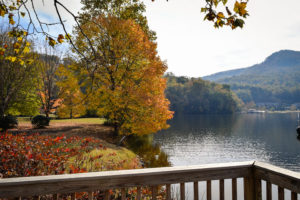 he lake. Rather than imagining yourself on the set of
he lake. Rather than imagining yourself on the set of  n nature. Perhaps take one last look back at the mountains, soon to return behind you. A pillow of smoke catches your eye, curling from the top of the mountain in a small patch.
n nature. Perhaps take one last look back at the mountains, soon to return behind you. A pillow of smoke catches your eye, curling from the top of the mountain in a small patch. 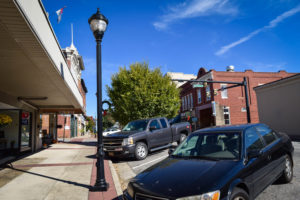 s a rich taste of North Carolina history and tradition. Yet the expectation of the town on a Sunday late afternoon–everyone would be leaving church, taking the dog for a walk, or going to lunch on their day off–was disrupted by a quite different reality.
s a rich taste of North Carolina history and tradition. Yet the expectation of the town on a Sunday late afternoon–everyone would be leaving church, taking the dog for a walk, or going to lunch on their day off–was disrupted by a quite different reality. oughout the street from a series of unseen speakers. The music could be described as a marriage of jazz piano and elevator music, perhaps meant to be a nice backdrop to the sounds of engines and human voices. The bizarre ambience, one reminiscent of a post-disillusioned movie, would still not be the main source of disappointment in Lenoir. The greatest disappointment offered by a quiet Sunday in this town, is that a walk along the main street revealed Lenoir has a lot to offer. Amongst a few cafes, the town’s GOP headquarters, and small markets, it seemed every other storefront was an art gallery or antique shop–both retailers for town character, personality, history, and secrets. In an eclectic collection of castaway personal belongings and artistic expression, these are the shops that give define Lenoir local flavor. The storefront windows were decorated with autumnal displays, from puppets, to art easels made of birch branches, to leaves and twigs perched with fake birds. Yet each was closed. Not a single site was open. Walks around square blocks, the real estate turning to banks and insurance fronts the farther the sidewalk talks you the center of town, and a feeling of defeat sinks into the sunny day.
oughout the street from a series of unseen speakers. The music could be described as a marriage of jazz piano and elevator music, perhaps meant to be a nice backdrop to the sounds of engines and human voices. The bizarre ambience, one reminiscent of a post-disillusioned movie, would still not be the main source of disappointment in Lenoir. The greatest disappointment offered by a quiet Sunday in this town, is that a walk along the main street revealed Lenoir has a lot to offer. Amongst a few cafes, the town’s GOP headquarters, and small markets, it seemed every other storefront was an art gallery or antique shop–both retailers for town character, personality, history, and secrets. In an eclectic collection of castaway personal belongings and artistic expression, these are the shops that give define Lenoir local flavor. The storefront windows were decorated with autumnal displays, from puppets, to art easels made of birch branches, to leaves and twigs perched with fake birds. Yet each was closed. Not a single site was open. Walks around square blocks, the real estate turning to banks and insurance fronts the farther the sidewalk talks you the center of town, and a feeling of defeat sinks into the sunny day.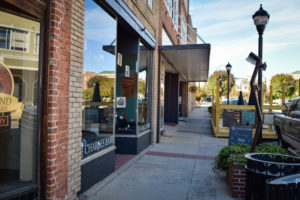 one finds Charlie’s Pub. It seemed the Pub shared the same menu as the Bistro, but with a different wood-panel and booth atmosphere. A table at the back of the restaurant sat regally, occupied by a family of 10+ dressed up in what looked to be church gear as a long table. Off to the side sat a priest and two elderly women, dressed to the nines, sharing lunch and forkfuls of pie.
one finds Charlie’s Pub. It seemed the Pub shared the same menu as the Bistro, but with a different wood-panel and booth atmosphere. A table at the back of the restaurant sat regally, occupied by a family of 10+ dressed up in what looked to be church gear as a long table. Off to the side sat a priest and two elderly women, dressed to the nines, sharing lunch and forkfuls of pie.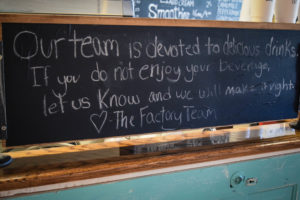 o the town. It turns out the shop had only been open for six months and was part of the new effort to revitalize downtown Mocksville.
o the town. It turns out the shop had only been open for six months and was part of the new effort to revitalize downtown Mocksville. 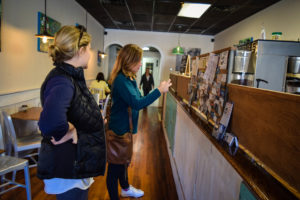 the barista, Ayenna, explained a bit more about Factory, as well as what it means to be a Mocksville local. She confirmed that The Factory was the newest addition to downtown Mocksville, but the building itself was historically valuable, once a pharmacy from the early 1900’s. To pay homage to what the building once was, the owners hung up that bike–which once belonged to the pharmacist–on the wall. “He used to ride the bike up and down main street to make prescription deliveries to people’s homes,” Ayenna said. “The pharmacist knew where everyone lived and what each family’s’ prescriptions were.”
the barista, Ayenna, explained a bit more about Factory, as well as what it means to be a Mocksville local. She confirmed that The Factory was the newest addition to downtown Mocksville, but the building itself was historically valuable, once a pharmacy from the early 1900’s. To pay homage to what the building once was, the owners hung up that bike–which once belonged to the pharmacist–on the wall. “He used to ride the bike up and down main street to make prescription deliveries to people’s homes,” Ayenna said. “The pharmacist knew where everyone lived and what each family’s’ prescriptions were.”  school homecoming game is one of the most exciting events in Mocksville during the fall. Ayenna pointed to the windows of the town’s favorite pub across the street, scrawled in orange paint: Beat the Mustangs! Evidently the homecoming game was the night before and has been held in the same location for 65 years. “The whole community came out and they had all of the homecoming kings and queens from years’ past come out on the field,” said Ayenna.
school homecoming game is one of the most exciting events in Mocksville during the fall. Ayenna pointed to the windows of the town’s favorite pub across the street, scrawled in orange paint: Beat the Mustangs! Evidently the homecoming game was the night before and has been held in the same location for 65 years. “The whole community came out and they had all of the homecoming kings and queens from years’ past come out on the field,” said Ayenna.

